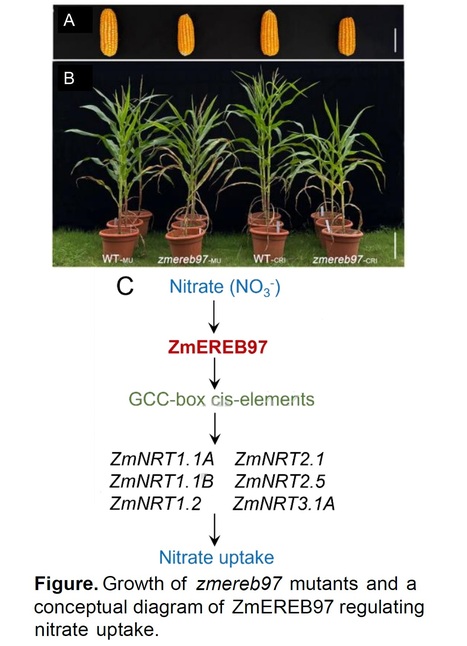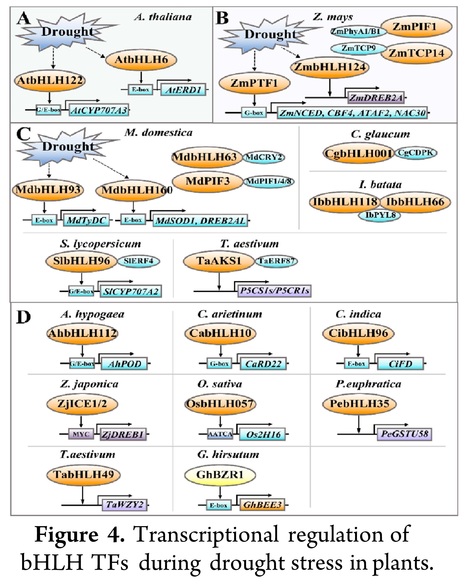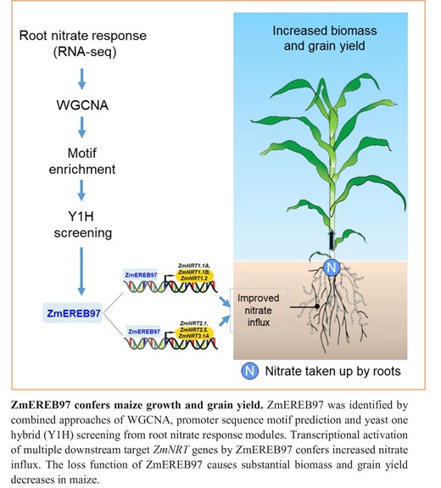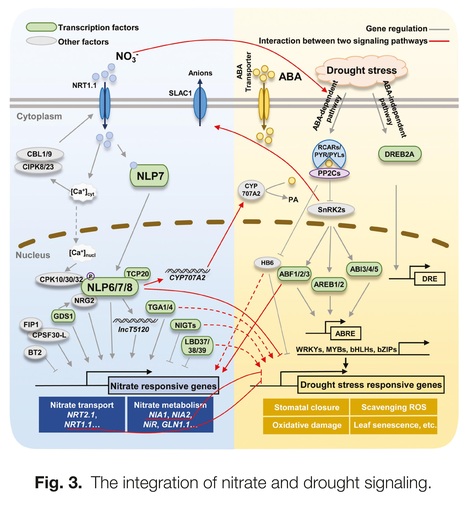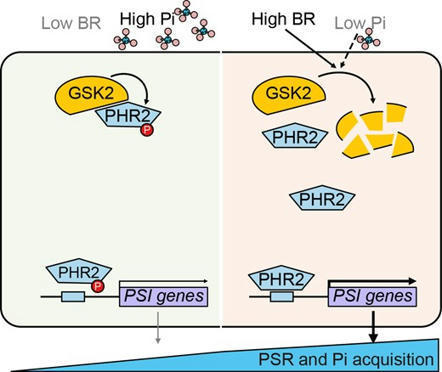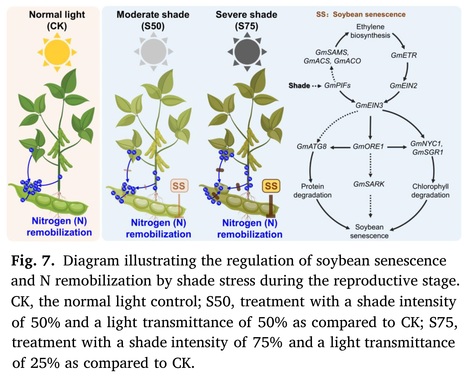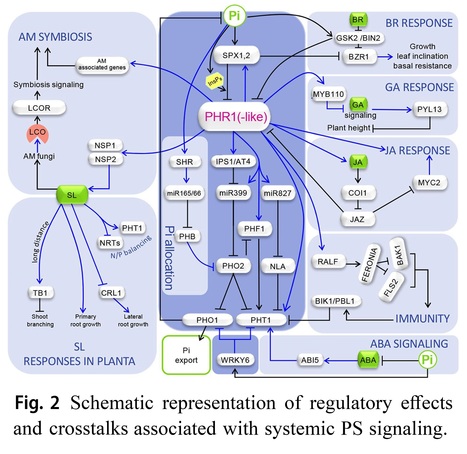 Your new post is loading...
 Your new post is loading...
Authors: Nidhi Kandhol, Sangeeta Pandey, Vijay Pratap Singh, Luis Herrera-Estrella, Lam-Son Phan Tran and Durgesh Kumar Tripathi.
Research (2024)
Abstract: "The menace of drought has persistently loomed over global crop production, posing a significant threat to agricultural sustainability. Research on drought stress highlights the significant role of the phytohormone abscisic acid (ABA) in orchestrating plant responses to drought conditions. ABA regulates various drought/dehydration-responsive genes, initiates stomatal closure, and influences cellular responses to drought stress. Additionally, plants employ a phosphate starvation response (PSR) mechanism to manage phosphate (Pi) deficiency, with ABA playing a role in its regulation. However, despite intensive research in these fields, the precise connection among PSRs, drought stress, and ABA signalling still needs to be determined. The recent study by Nagatoshi and colleagues (2023) demonstrates that PSR-related gene induction occurs before the induction of ABA-responsive genes under progressive mild drought. Mild drought decreases Pi uptake and contents in plants, triggering PSRs, which play an important role in plant growth during mild drought. Both ABA-responsive and PSR-related gene expression could indicate plant perception of external moisture conditions. Thus, integrating the information regarding their associated gene expression with soil moisture contents and thermographic data can enable timely irrigation optimization to mitigate the effect of drought on crop productivity."
Authors: Yuqi Liu, Shangyu Chen, Sikander Pal, Jingquan Yu, Yanhong Zhou, Lam-Son Phan Tran and Xiaojian Xia.
New Crops (2024)
Abstract: "Plants have evolved varied structures for environmental adaptation. Shoot branching, as a part of plant architecture, influences the allocation of sugars produced by photosynthesis and thus greatly impacts crop yields. The activity of axillary meristem, and apical dominance governs the shoot branching patterns. In this review, we summarize the key factors involved in the formation of lateral branches, and the mechanisms of how these factors are interconnected. In particular, we focus on recent advances in understanding how sugar and environmental signals affect the hormonal signaling network to regulate apical dominance. Ultimately, we propose that epigenetic modifications are critical mechanisms underlying the plasticity of shoot branching, and that precise targeted gene editing is promising for shaping the ideal plant architecture."
Author: Munkhtsetseg Tsednee.
Plant Physiology (2024)
Excerpts: "In this issue of Plant Physiology, Wu et al. (2024) investigated the N responses in two maize lines, and identified a transcription factor (TF) involved in the regulation of nitrate uptake. First, the authors looked at gene expression in response to nitrogen recovery after depletion. By correlating gene co-expression network data with nitrate supplied time points, they successfully identified four consensus N-related modules conserved in two representative maize lines, B73 and Mo17."
"Moreover, zmereb97 mutants accumulate biomass more slowly than wild-type plants both under nitrate-limited and fully nitrate-supplied conditions, and mutants produce less grains, with 13 to 15% reductions in grain yields compared to wild-type plants under soil growth conditions (Fig. A and B)."
"To reveal how ZmEREB97 regulates nitrate uptake, the authors conducted yeast one hybrid assays using 17 selected nitrate transporter (NRT) genes potentially regulated by ZmEREB97 and showed that six ZmNRTs interact with ZmEREB97 via GCC-elements in their promoters for transcriptional activation. These six are the transporters mainly responsible for the nitrate uptake from soil (Fig. C). Direct controlling of uptake transporters is vital in that it is the primary source of nutrients into roots. Therefore, Wu et al. (2024) have identified a critical player, ZmEREB97, as a major positive regulator in nitrate response in maize."
Authors: Pei Lei, Yaxuan Jiang, Yong Zhao, Mingquan Jiang, Ximei Ji, Le Ma, Guangze Jin, Jianxin Li, Subin Zhang, Dexin Kong, Xiyang Zhao and Fanjuan Meng.
Journal of Agricultural and Food Chemistry (2024)
Abstract: "Abiotic stresses including cold, drought, salt, and iron deficiency severely impair plant development, crop productivity, and geographic distribution. Several bodies of research have shed light on the pleiotropic functions of BASIC HELIX–LOOP–HELIX (bHLH) proteins in plant responses to these abiotic stresses. In this review, we mention the regulatory roles of bHLH TFs in response to stresses such as cold, drought, salt resistance, and iron deficiency, as well as in enhancing grain yield in plants, especially crops. The bHLH proteins bind to E/G-box motifs in the target promoter and interact with various other factors to form a complex regulatory network. Through this network, they cooperatively activate or repress the transcription of downstream genes, thereby regulating various stress responses. Finally, we present some perspectives for future research focusing on the molecular mechanisms that integrate and coordinate these abiotic stresses. Understanding these molecular mechanisms is crucial for the development of stress-tolerant crops."
Authors: s Qi Wu, Jinyan Xu, Yingdi Zhao, Yuancong Wang, Ling Zhou, Lihua Ning, Sergey Shabala and Han Zhao.
Plant Physiology (2024)
One-sentence summary: An ethylene response transcription factor plays an important role in the nitrogen-signaling network and in optimizing nitrate uptake in maize.
Abstract: "Maize (Zea mays L.) has very strong requirements for nitrogen. However, the molecular mechanisms underlying the regulations of nitrogen uptake and translocation in this species are not fully understood. Here, we report that an APETALA2/ETHYLENE RESPONSE FACTOR (AP2/ERF) transcription factor ZmEREB97 functions as an important regulator in the N-signaling network in maize. Predominantly expressed and accumulated in main root and lateral root primordia, ZmEREB97 rapidly responded to nitrate treatment. By overlapping the analyses of differentially expressed genes and conducting a DAP-seq assay, we identified 1446 potential target genes of ZmEREB97. Among these, 764 genes were co-regulated in two lines of zmereb97 mutants. Loss of function of ZmEREB97 substantially weakened plant growth under both hydroponic and soil conditions. Physiological characterization of zmereb97 mutant plants demonstrated that reduced biomass and grain yield were both associated with reduced nitrate influx, decreased nitrate content and less N accumulation. We further demonstrated that ZmEREB97 directly targets and regulates the expression of six ZmNRT genes by binding to the GCC box-related sequences in gene promoters. Collectively, these data suggest that ZmEREB97 is a major positive regulator of the nitrate response and that it plays an important role in optimizing nitrate uptake, offering a target for improvement of nitrogen use efficiency in crops."
Authors: Tomás Urzúa Lehuedé, Victoria Berdion Gabarain, Tomas Moyano, Lucia Ferrero, Miguel Angel Ibeas, Hernan Salinas-Grenet, Gerardo Núñez-Lillo, Romina Acha, Jorge Perez, Florencia Perotti, Virginia Natali Miguel, Fiorella Paola Spies, Miguel A. Rosas, Michitaro Shibata, Diana R. Rodríguez-García, Adrian A. Moreno, Keiko Sugimoto, Karen Sanguinet, Claudio Meneses, Raquel L. Chan, Federico Ariel, Jose M. Alvarez and José M. Estevez.
bioRxiv (2024)
Abstract: "The root hair (RH) cells can elongate to several hundred times their initial size, and are an ideal model system for investigating cell size control. Their development is influenced by both endogenous and external signals, which are combined to form a integrative response. Surprisingly, a low temperature condition of 10°C causes an increased RH growth in Arabidopsis and in several monocots, even when the development of the rest of the root and aerial parts of the plant are halted. Previously, we demonstrated a strong correlation between the growth response and a significant decrease in nutrient availability in the medium under low temperature conditions. However, the molecular basis responsible for receiving and transmitting signals related to the availability of nutrients in the soil, and their relation to plant development, remain largely unknown. We decided to further investigate the intricate molecular processes behind the particular responsiveness of this root cell type at low temperature. In this study, we have discovered a gene regulatory network (GRN) controlling early transcriptome responses to low temperature. This GNR is commanded by specific transcription factors (FTs), namely ROOT HAIR DEFECTIVE 6-LIKE 4 (RSL4), a member of the homeodomain leucine zipper (HD-Zip I) group I 13 (AtHB13), the trihelix TF GT2-LIKE1 (GTL1), and a previously unidentified MYB-like TF (AT2G01060). Furthermore, we have identified four downstream RSL4 targets AtHB16, AtHB23, EARLY-RESPONSIVE TO DEHYDRATION 7 (ERD7) and ERD10 suggesting their participation in the regulation of RH development under these conditions. Functional analysis shows that such components of the RSL4-dependent transcriptional cascade influence the subsequent RH growth response to low temperature. These discoveries enhance our comprehension of how plants synchronize the RH growth in response to variations in temperature and nutrient availability at the cellular level."
Authors: Mengdi Fu, Xiaolei Yao, Xiaolin Li, Jing Liu, Mengyan Bai, Zijun Fang, Jiming Gong, Yuefeng Guan and Fang Xie.
The Plant Journal (2024)
Significance Statement: GmNLP1 and GmNLP4 activate nitrate-induced CLE peptides NIC1a/b to mediate nitrate-regulated root nodulation.
Abstract: "Symbiotic nitrogen fixation is an energy-intensive process, to maintain the balance between growth and nitrogen fixation, high concentrations of nitrate inhibit root nodulation. However, the precise mechanism underlying the nitrate inhibition of nodulation in soybean remains elusive. In this study, CRISPR-Cas9-mediated knockout of GmNLP1 and GmNLP4 unveiled a notable nitrate-tolerant nodulation phenotype. GmNLP1b and GmNLP4a play a significant role in the nitrate-triggered inhibition of nodulation, as the expression of nitrate-responsive genes was largely suppressed in Gmnlp1b and Gmnlp4a mutants. Furthermore, we demonstrated that GmNLP1b and GmNLP4a can bind to the promoters of GmNIC1a and GmNIC1b and activate their expression. Manipulations targeting GmNIC1a and GmNIC1b through knockdown or overexpression strategies resulted in either increased or decreased nodule number in response to nitrate. Additionally, transgenic roots that constitutively express GmNIC1a or GmNIC1b rely on both NARK and hydroxyproline O-arabinosyltransferase RDN1 to prevent the inhibitory effects imposed by nitrate on nodulation. In conclusion, this study highlights the crucial role of the GmNLP1/4-GmNIC1a/b module in mediating high nitrate-induced inhibition of nodulation."
Authors: Isabel Cristina Vélez-Bermúdez and Wolfgang Schmidt.
Nature Plants (2024)
Summary: "The functions of a small family of non-secreted peptides, originally identified as critical communicators of the plant’s iron status, have expanded. The involvement of these effectors in disparate signalling cascades underlines the pivotal role peptides have in responses to the environment."
Authors: Yiran Xu, Shengdong Qi, Yong Wang and Jingbo Jia.
Journal of Experimental Botany (2024)
One-sentence summary: This review summarizes the interplay between nitrate and abscisic acid and provides research perspectives for breeding high nitrogen use efficiency and stress-tolerant crop varieties.
Abstract: "To meet the demands of the new Green Revolution and sustainable agriculture, it is important to develop crop varieties with improved yield, nitrogen use efficiency, and stress resistance. Nitrate is the major form of inorganic nitrogen available for plant growth in many well-aerated agricultural soils, and acts as a signaling molecule regulating plant development, growth, and stress responses. Abscisic acid (ABA), an important phytohormone, plays vital roles in integrating extrinsic and intrinsic responses and mediating plant growth and development in response to biotic and abiotic stresses. Therefore, elucidating the interplay between nitrate and ABA can contribute to crop breeding and sustainable agriculture. Here, we review studies that have investigated the interplay between nitrate and ABA in root growth modulation, nitrate and ABA transport processes, seed germination regulation, and drought responses. We also focus on nitrate and ABA interplay in several reported omics analyses with some important nodes in the crosstalk between nitrate and ABA. Through these insights, we proposed some research perspectives that could help to develop crop varieties adapted to a changing environment and to improve crop yield with high nitrogen use efficiency and strong stress resistance."
Authors: Xiuzhen Kong, Suhang Yu, Yali Xiong, Xiaoyun Song, Lucia Nevescanin-Moreno, Xiaoqing Wei, Jinliang Rao, Hu Zhou, Malcolm J. Bennett, Bipin K. Pandey and Guoqiang Huang.
Current Biology (2024)
Editor's view: Kong et al. provide evidence for the anchorage functions of root hairs in root penetration, a process that is regulated by OsYUC8-mediated auxin biosynthesis and OsAUX1-mediated auxin transport when roots encounter a compacted barrier.
Highlights • Mechanical impedance induced the upregulation of auxin biosynthesis in root apex • Auxin transport from root tip to hair zone promoted root penetration via root hair • Mutants of OsYUC8 and OsAUX1 had trouble penetrating into the compacted layer • Increased root hair length provided greater anchorage force for root penetration
Abstract: "Compacted soil layers adversely affect rooting depth and access to deeper nutrient and water resources, thereby impacting climate resilience of crop production and global food security. Root hair plays well-known roles in facilitating water and nutrient acquisition. Here, we report that root hair also contributes to root penetration into compacted layers. We demonstrate that longer root hair, induced by elevated auxin response during a root compaction response, improves the ability of rice roots to penetrate harder layers. This compaction-induced auxin response in the root hair zone is dependent on the root apex-expressed auxin synthesis gene OsYUCCA8 (OsYUC8), which is induced by compaction stress. This auxin source for root hair elongation relies on the auxin influx carrier AUXIN RESISTANT 1 (OsAUX1), mobilizing this signal from the root apex to the root hair zone. Mutants disrupting OsYUC8 and OsAUX1 genes exhibit shorter root hairs and weaker penetration ability into harder layers compared with wild type (WT). Root-hair-specific mutants phenocopy these auxin-signaling mutants, as they also exhibit an attenuated root penetration ability. We conclude that compaction stress upregulates OsYUC8-mediated auxin biosynthesis in the root apex, which is subsequently mobilized to the root hair zone by OsAUX1, where auxin promotes root hair elongation, improving anchorage of root tips to their surrounding soil environment and aiding their penetration ability into harder layers."
Authors: Wenyuan Ruan, Meina Guo and Keke Yi.
Molecular Plant (2024)
Excerpts: "A recent study by Dr. Hong's group (He et al, 2024) has shed new light on the roles of PHRs and SPXs in modulating the trade-off between growth and immunity in response to Pi availability in rice. They elegantly demonstrated that the OsPHR2-OsSPX1/2 module switches JA and BR signaling outputs in response to Pi availability. Under Pi-sufficient conditions, OsSPX1/2 inhibits OsPHR2 from activating JA-mediated defense. Meanwhile, OsBZR1 confers basal resistance by regulating sakuranetin biosynthesis. Under Pi starvation conditions, OsPHR2 dissociates from the OsPHR2-OsSPX1/2 complex and turns on JA signaling and sakuranetin accumulation to suppress Magnaporthe oryzae growth; meanwhile, the released OsSPX1/2 binds to OsBZR1 to suppress BR signaling and plant growth."
"The findings by Hong's group not only highlight the functional diversity of the central Pi signaling regulators but also underscore their crucial role in modulating the trade-off between growth and immunity in plants. These regulators extend beyond their traditional function in Pi signaling and homeostasis, playing a critical role in regulating the interactions between plants and various biotic species, including both harmful and beneficial organisms such as bacteria, fungi, and insects (Figure 1)."
Authors: Sufian Ikram, Yang Li, Chai Lin, Debao Yi, Wang Heng, Qiang Li, Lu Tao, Yu Hongjun and Jiang Weijie.
Journal of Plant Physiology (2024)
Abstract: "Selenium (Se) is an essential micronutrient for both human and animals. Plants serve as the primary source of Se in the food chain. Se concentration and availability in plants is influenced by soil properties and environmental conditions. Optimal Se levels promote plant growth and enhance stress tolerance, while excessive Se concentration can result in toxicity. Se enhances plants ROS scavenging ability by promoting antioxidant compound synthesis. The ability of Se to maintain redox balance depends upon ROS compounds, stress conditions and Se application rate. Furthermore, Se-dependent antioxidant compound synthesis is critically reliant on plant macro and micro nutritional status. As these nutrients are fundamental for different co-factors and amino acid synthesis. Additionally, phytohormones also interact with Se to promote plant growth. Hence, utilization of phytohormones and modified crop nutrition can improve Se-dependent crop growth and plant stress tolerance. This review aims to explore the assimilation of Se into plant proteins, its intricate effect on plant redox status, and the specific interactions between Se and phytohormones. Furthermore, we highlight the proposed physiological and genetic mechanisms underlying Se-mediated phytohormone-dependent plant growth modulation and identified research opportunities that could contribute to sustainable agricultural production in the future."
Authors: Guoxia Zhang, Hongru Wang, Xiangle Ren, Yunhua Xiao, Dapu Liu, Wenjing Meng, Yahong Qiu, Bin Hu, Qingjun Xie, Chengcai Chu and Hongning Tong.
The Plant Cell (2024)
One-sentence summary: Brassinosteroids modulate phosphate homeostasis by phosphorylating a serine residue of OsPHR2 through GSK2, thereby attenuating its DNA-binding activity.
Abstract: "Brassinosteroids (BRs) are widely used as plant growth regulators in modern agriculture. Understanding how BRs regulate nutrient signaling is crucial for reducing fertilizer usage. Here we elucidate that the central BR signaling inhibitor GSK3/SHAGGY-LIKE KINASE2 (GSK2) interacts directly with and phosphorylates PHOSPHATE STARVATION RESPONSE2 (OsPHR2), the key regulator of phosphate (Pi) signaling, to suppress its transcription factor activity in rice (Oryza sativa). We identify a critical phosphorylation site at serine residue S269 of OsPHR2 and demonstrate that phosphorylation by GSK2 or phosphor-mimic mutation of S269 substantially impairs the DNA-binding activity of OsPHR2, and thus diminishes expression of OsPHR2-induced genes and reduces Pi levels. Like BRs, Pi starvation noticeably induces GSK2 instability. We further show that this site-specific phosphorylation event is conserved in Arabidopsis (Arabidopsis thaliana), but varies among the PHR-family members, being present only in most land plants. These results unveil a distinctive post-transcriptional regulatory mechanism in Pi signaling by which BRs promote Pi acquisition, with a potential contribution to the environmental adaptability of plants during their evolution."
|
Authors: Aime Jaskolowski and Yves Poirier.
The Plant Journal (2024)
Significance Statement: When plants are subjected to a combination of biotic and abiotic stresses, the response to each individual stress is usually a poor predictor of the global response. Here, we show that when Arabidopsis plants are grown under phosphate deficiency, they increase the accumulation of the stress phytohormone abscisic acid, which in turn leads to higher susceptibility to infection by the necrotrophic fungus Botrytis cinerea, in part because of increased spore germination on the leaf surface.
Abstract: "Plants have evolved finely regulated defense systems to counter biotic and abiotic threats. In the natural environment, plants are typically challenged by simultaneous stresses and, amid such conditions, crosstalk between the activated signaling pathways becomes evident, ultimately altering the outcome of the defense response. As an example of combined biotic and abiotic stresses, inorganic phosphate (Pi) deficiency, common in natural and agricultural environments, can occur along with attack by the fungus Botrytis cinerea, a devastating necrotrophic generalist pathogen responsible for massive crop losses. We report that Pi deficiency in Arabidopsis thaliana increases its susceptibility to infection by B. cinerea by influencing the early stages of pathogen infection, namely spore adhesion and germination on the leaf surface. Remarkably, Pi-deficient plants are more susceptible to B. cinerea despite displaying the appropriate activation of the jasmonic acid and ethylene signaling pathways, as well as producing secondary defense metabolites and reactive oxygen species. Conversely, the callose deposition in response to B. cinerea infection is compromised under Pi-deficient conditions. The levels of abscisic acid (ABA) are increased in Pi-deficient plants, and the heightened susceptibility to B. cinerea observed under Pi deficiency can be reverted by blocking ABA biosynthesis. Furthermore, high level of leaf ABA induced by overexpression of NCED6 in Pi-sufficient plants also resulted in greater susceptibility to B. cinerea infection associated with increased spore adhesion and germination, and reduced callose deposition. Our findings reveal a link between the enhanced accumulation of ABA induced by Pi deficiency and an increased sensitivity to B. cinerea infection."
Authors: Qingjun Xie, Danni Wang, Yuting Ding, Wenshuo Gao, Jinghang Li, Chuanwang Cao, Lili Sun, Zhongyuan Liu and Caiqiu Gao.
Science of the Total Environment (2024)
Highlights: • Various plant hormones play roles in the accumulation of Cd in T. hispida. • ABA and ethylene antagonistic regulation of Cd accumulation in T. hispida • ThDRE1A regulates Cd accumulation by regulating ThABAH2.5 and ThACCO3.1.
Abstract: "Tamarix hispida is highly tolerant to salt, drought and heavy metal stress and is a potential material for the remediation of cadmium (Cd)-contaminated soil under harsh conditions. In this study, T. hispida growth and chlorophyll content decreased, whereas flavonoid and carotenoid contents increased under long-term Cd stress (25 d). The aboveground components of T. hispida were collected for RNA-seq to investigate the mechanism of Cd accumulation. GO and KEGG enrichment analyses revealed that the differentially expressed genes (DEGs) were significantly enriched in plant hormone-related pathways. Exogenous hormone treatment and determination of Cd2+ levels showed that ethylene (ETH) and abscisic acid (ABA) antagonists regulate Cd accumulation in T. hispida. Twenty-five transcription factors were identified as upstream regulators of hormone-related pathways. ThDRE1A, which was previously identified as an important regulatory factor, was selected for further analysis. The results indicated that ThABAH2.5 and ThACCO3.1 were direct target genes of ThDRE1A. The determination of Cd2+, ABA, and ETH levels indicated that ThDRE1A plays an important role in Cd accumulation through the antagonistic regulation of ABA and ethylene. In conclusion, these results reveal the molecular mechanism underlying Cd accumulation in plants and identify candidate genes for further research."
Authors: Malathi Bheri, Amit Kumar and Girdhar K. Pandey.
Trends in Plant Science (2024)
Abstract: "Potassium (K) is an essential macronutrient for plant development. Although the low-K+-responsive calcium (Ca2+) signaling pathway is known, its regulator remained elusive. Li et al. recently demonstrated that the target of rapamycin complex (TORC) and Ca2+ signaling pathways show reciprocal regulation of K+-responsive growth in plants."
Authors: Kiyoshi Yamazaki, Yoshihiro Ohmori, Hirokazu Takahashi, Atsushi Toyoda, Yutaka Sato, Mikio Nakazono and Toru Fujiwara.
Plant and Cell Physiology (2024)
Abstract: "Nutritropism is a positive tropism toward nutrients in plant roots. An NH4+ gradient is a nutritropic stimulus in rice (Oryza sativa L.). When rice roots are exposed to an NH4+ gradient generated around nutrient sources, root tips bend toward and coil around the sources. The molecular mechanisms are largely unknown. Here, we analyzed the transcriptomes of the inside and outside of bending root tips exhibiting nutritropism to reveal nutritropic signal transduction. Tissues facing the nutrient sources (inside) and away (outside) were separately collected by laser microdissection. Principal component analysis revealed distinct transcriptome patterns between the two tissues. Annotations of 153 differentially expressed genes implied that auxin, gibberellin and ethylene signaling were activated differentially between the sides of the root tips under nutritropism. Exogenous application of transport and/or biosynthesis inhibitors of these phytohormones largely inhibited the nutritropism. Thus, signaling and de novo biosynthesis of the three phytohormones are necessary for nutritropism. Expression patterns of IAA genes implied that auxins accumulated more in the inside tissues, meaning that ammonium stimulus is transduced to auxin signaling in nutritropism similar to gravity stimulus in gravitropism. SAUR and expansin genes, which are known to control cell wall modification and to promote cell elongation in shoot gravitropism, were highly expressed in the inside tissues rather than the outside tissues, and our transcriptome data are unexplainable for differential elongation in root nutritropism."
Authors: Mahamud Hossain Al-Mamun, Christopher Ian Cazzonelli and Priti Krishna.
Frontiers in Plant Science (2024)
Abstract: "Plants modify their root system architecture (RSA) in response to nitrogen (N) deficiency. The plant steroidal hormone, brassinosteroid (BR), plays important roles in root growth and development. This study demonstrates that optimal levels of exogenous BR impact significant increases in lateral root length and numbers in Arabidopsis seedlings under mild N-deficient conditions as compared to untreated seedlings. The impact of BR on RSA was stronger under mild N deficiency than under N-sufficient conditions. The BR effects on RSA were mimicked in dominant mutants of BZR1 and BES1 (bzr1-1D and bes1-D) transcription factors, while the RSA was highly reduced in the BR-insensitive mutant bri1-6, confirming that BR signaling is essential for the development of RSA under both N-sufficient and N-deficient conditions. Exogenous BR and constitutive activity of BZR1 and BES1 in dominant mutants led to enhanced root meristem, meristematic cell number, and cortical cell length. Under mild N deficiency, bzr1-1D displayed higher fresh and dry shoot weights, chlorophyll content, and N levels in the shoot, as compared to the wild type. These results indicate that BR modulates RSA under both N-sufficient and N-deficient conditions via the transcription factors BES1/BZR1 module and confers tolerance to N deficiency."
Author: Gwendolyn K. Kirschner.
The Plant Journal (2024)
Excerpts: "Udvardi and Sonali Roy, a former post-doctoral fellow with Udvardi at the Noble Research Institute and now an assistant professor at Tennessee State University, together with a team of experts on legume rhizobial symbiosis from Oklahoma, Cambridge and Shanghai, analysed the role of GLVs for nodule development and positioning in more detail (Roy et al., 2024)."
"Transcriptional reporter expression in transgenic hairy roots showed that the expression of the five GLVs overlapped at sites of nodule initiation (Figure 1b). Out of these, MtGLV6, MtGLV9 and MtGLV10 were induced by short-term nitrogen deprivation stress, suggesting a role in early stages of symbiosis, such as the dedifferentiation of cortical cells or the regulation of early nodulin genes."
"The nitrogen-induced GLV10 peptide could integrate the nitrogen signal from the soil to adaptation of the root architecture. GLV10p treatment also led to more microcolonies and infection thread initiations. The authors hypothesise that the increase in infection might be a compensation for the reduction in nodule number: The plant initiates more infection threads to make an optimal number of nodules and derive sufficient nitrogen."
Authors: Ping Yun, Cengiz Kaya and Sergey Shabala.
The Crop Journal (2024)
Abstract: "Salinity stress is a major environmental stress affecting crop productivity, and its negative impact on global food security is only going to increase, due to current climate trends. Salinity tolerance was present in wild crop relatives but significantly weakened during domestication. Regaining it back requires a good understanding of molecular mechanisms and traits involved in control of plant ionic and ROS homeostasis. This review summarizes our current knowledge on the role of major plant hormones (auxin, cytokinins, abscisic acid, salicylic acid, and jasmonate) in plants adaptation to soil salinity. We firstly discuss the role of hormones in controlling root tropisms, root growth and architecture (primary root elongation, meristematic activity, lateral root development, and root hairs formation). Hormone-mediated control of uptake and sequestration of key inorganic ions (sodium, potassium, and calcium) is then discussed followed by regulation of cell redox balance and ROS signaling in salt-stressed roots. Finally, the role of epigenetic alterations such as DNA methylation and histone modifications in control of plant ion and ROS homeostasis and signaling is discussed. This data may help develop novel strategies for breeding and cultivating salt-tolerant crops and improving agricultural productivity in saline regions."
Authors: Juncai Deng, Xiangqing Huang, Jianhua Chen, Bartel Vanholme, Jinya Guo, Yuanyuan He, Wenting Qin, Jing Zhang, Wenyu Yang and Jiang Liu.
Plant Physiology and Biochemistry (2024)
Highlights: • Shade stress leads to premature senescence in soybean plants. • Ethylene biosynthesis and signal transduction are induced to regulate soybean plant senescence. • Shade stress retains nitrogen in soybean vegetative organs and impedes the remobilization of nitrogen from these organs. • These negative impacts can be mitigated by reducing the intensity of shade stress through field layout optimization.
Abstract: "In gramineae-soybean intercropping systems, shade stress caused by taller plants impacts soybean growth specifically during the reproductive stage. However, the effects of shade stress on soybean senescence remain largely unexplored. In this research, we applied artificial shade treatments with intensities of 75% (S75) and 50% (S50) to soybean plants at the onset of flowering to simulate the shade stress experienced by soybeans in the traditional and optimized maize-soybean intercropping systems, respectively. Compared to the normal light control, both shade treatments led to a rapid decline in the dry matter content of soybean vegetative organs and accelerated their abscission. Moreover, shade treatments triggered the degradation of chlorophyll and soluble proteins in leaves and increased the expression of genes associated with leaf senescence. Metabolic profiling further revealed that ethylene biosynthesis and signal transduction were induced by shade treatment. In addition, the examination of nitrogen content demonstrated that shade treatments impeded the remobilization of nitrogen in vegetative tissues, consequently reducing the seed nitrogen harvest. It's worth noting that these negative effects were less pronounced under the S50 treatment compared to the S75 treatment. Taken together, this research demonstrates that shade stress during the reproductive stage accelerates soybean senescence and impedes nitrogen remobilization, while optimizing the field layout to improve soybean growth light conditions could mitigate these challenges in the maize-soybean intercropping system."
Authors: María Isabel Puga, César Poza-Carrión, Iris Martinez-Hevia, Laura Perez-Liens and Javier Paz-Ares
Journal of Plant Research (2024)
Abstract: "Phosphorus is indispensable for plant growth and development, with its status crucial for determining crop productivity. Plants have evolved various biochemical, morphological, and developmental responses to thrive under conditions of low P availability, as inorganic phosphate (Pi), the primary form of P uptake, is often insoluble in soils. Over the past 25 years, extensive research has focused on understanding these responses, collectively forming the Pi starvation response system. This effort has not only expanded our knowledge of strategies to cope with Pi starvation (PS) but also confirmed their adaptive significance. Moreover, it has identified and characterized numerous components of the intricate regulatory network governing P homeostasis. This review emphasizes recent advances in PS signaling, particularly highlighting the physiological importance of local PS signaling in inhibiting primary root growth and uncovering the role of TORC1 signaling in this process. Additionally, advancements in understanding shoot-root Pi allocation and a novel technique for studying Pi distribution in plants are discussed. Furthermore, emerging data on the regulation of plant-microorganism interactions by the PS regulatory system, crosstalk between the signaling pathways of phosphate starvation, phytohormones and immunity, and recent studies on natural variation in Pi homeostasis are addressed.
Authors: Yuqing Zhao, Qing Han and Dawei Zhang.
Plant and Cell Physiology (2024)
Abstract: "Due to their sessile lifestyle, plants need to optimize their growth in order to adapt to ever-changing environments. Plants receive stimuli from the environment and convert them into cellular responses. Brassinosteroids (BRs), as growth-promoting steroid hormones, play a significant role in the tradeoff between growth and environmental responses. Here, we provide a comprehensive summary for understanding the crosstalk between BR and various environmental stresses, including water availability, temperature fluctuations, salinization, nutrient deficiencies and diseases. We also highlight the bottlenecks that need to be addressed in future studies. Ultimately, we suppose to improve plant environmental adaptability and crop yield by excavating natural BR mutants or modifying BR signaling and its targets."
Authors: Yuqing He, Yao Zhao, Jitao Hu, Lanlan Wang, Linying Li, Xueying Zhang, Zhongjing Zhou, Lili Chen, Hua Wang, Jiaoyu Wang and Gaojie Hong.
Molecular Plant (2024)
Abstract: "The growth-promoting hormones brassinosteroids (BRs) and their key signaling component BZR1 play a vital role in balancing normal growth and defense reactions. Here, we discovered that BRs and OsBZR1 upregulated sakuranetin accumulation and conferred basal defense against Magnaporthe oryzae infection under normal conditions. Resource shortages, including phosphate (Pi) deficiency, potentially disrupt this growth–defense balance. OsSPX1 and OsSPX2 have been reported to sense Pi concentration and interact with the Pi signal mediator OsPHR2, thus regulating Pi starvation responses. In this study, we discovered that OsSPX1/2 interacts with OsBZR1 in both Pi-sufficient and Pi-deficient conditions, inhibiting BR-responsive genes. When Pi is sufficient, OsSPX1/2 is captured by OsPHR2, enabling most of OsBZR1 to promote plant growth and maintain basal resistance. In response to Pi starvation, more OsSPX1/2 is released from OsPHR2 to inhibit OsBZR1 activity, resulting in slower growth. Collectively, our study reveals that the OsBZR1–SPX1/2 module balances the plant growth–immunity trade-off in response to Pi availability."
Author: Vicky Howe.
The Plant Cell (2024)
Excerpts: "In search of potential genetic targets that could boost Pi absorption in rice (Oryza sativa), Guoxia Zhang and coauthors (Zhang et al. 2024) investigated the regulation of the Pi-starvation response (PSR) and identified an intersection between the PSR and brassinosteroid (BR) signaling pathway (see Figure)."
"In this study, Zhang and colleagues showed that, upon Pi starvation, rice mutants with over-active BR signaling had increased expression of classical Pi-starvation-induced genes, suggesting that BR signaling amplifies PSR. This prompted the authors to examine PHOSPHATE STARVATION RESPONSE2 (OsPHR2), a major regulator of PSR. They found that the central inhibitor of BR signaling, GSK3/SHAGGY-LIKE KINASE 2 (GSK2), also down-regulates PSR by phosphorylating OsPHR2 at a serine residue, S269. Thus, over-activation of BR signaling results in a stronger PSR, while BR and PSR can be simultaneously inhibited."
"Finally, the group reasoned that, being upstream of GSK2, altering BR levels should have downstream effects on Pi levels. Indeed, mutants with impaired BR signaling had lower Pi levels, while mutants with enhanced BR signaling had higher Pi levels, demonstrating that up-regulating BR signaling can boost PSR to increase Pi absorption."
|




 Your new post is loading...
Your new post is loading...

